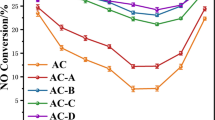Abstract
Coconut shell, being a good carbon precursor and having a regular porous structure, was chosen for production of carbonic materials in this work. Metal doping on the coconut char was used to develop catalytic centers for hydrocarbon cracking and thereby obtain a product with good microporosity. Magnesium, calcium, cobalt, copper and nickel doping on the coconut char was done by soaking the coconut char in the aqueous solutions of the respective metal salt and further calcining. The characterization of the product samples was done by the measurement of surface area, adsorption capacity of CO2, N2, CH4, and SEM analysis. The micro pore area obtained by using CO2 adsorption at 298 K was found to be > 400 m2/g for samples prepared from coconut char impregnated with metal. The adsorption capacity of magnesium-doped sample was found to be 98 mg/g, whereas that for a sample prepared from non-impregnated coconut char was 55 mg/g. SEM analysis was conducted to study the morphology and nature of the samples prepared.
Similar content being viewed by others
References
Bae, Y. S., Moon, J.H., Ahn, H. and Lee, C.H., “Effects of Adsorbate Properties on Adsorption Mechanism in a Carbon Molecular Sieve,”Korean J. Chem. Eng.,21, 712 (2004).
de la Casa-Lillo, M. A., Moore, B. C., Cazorla-Amoros, D. and LinaresSolano, A., “Molecular Sieve Properties Obtained by Cracking of Methane on Activated Carbon Fibers,”Carbon,40, 2489 (2002).
Freitas, M.M.A. and Figueiredo, J. L., “Preparation of Carbon Molecular Sieves for Gas Separations by Modification of the Pore Sizes of Activated Carbons,”Fuel,80, 1 (2001).
Guo, J. and Lua, A. C., “Textural Characterization of Activated Carbons Prepared from Oil-palm Stones Pre-treated with Various Impregnating Agents,”J. Porous Materials,7, 491 (2000).
Harnit, K. C., Francis, E.N., Martin, L. S. and Thomas, K.M., “Kinetics of Adsorption and Diffusional Characteristics of Carbon Molecular Sieves,”Carbon,33, 1405 (1995).
Jee, J. G., Lee, S. J. and Lee, C. H., “Comparison of the Adsorption Dynamics of Air on Zeolite 5A and Carbon Molecular Sieve Beds,”Korean J. Chem. Eng.,21, 1183 (2004).
Justin, S. J.H., Richard, W. J. and Ian, M.M., “A Study of the Structure Sensitivity of the Exchange of Oxygen with the Surface of Magnesium Oxide,”J. Molecular catalysis A, 141 (1999).
Kim, T. H., Vijayalakshmi, S., Son, S. J. and Kim, J. D., “The Pore Mouth Tailoring of Coal and Coconut Char through Acid Treatment Followed by Coke Deposition,”J. Porous Materials,9, 279 (2002).
Kyotani, T., “Control of Pore Structure in Carbon,”Carbon,38, 269 (2000).
Marquez, F. M., Cordero, T., Rodriguez, M. T. and Rodriguez, J. J., “CO2 and Steam Gasification of a Grapefruit Skin Char,”Fuel,81, 423 (2002).
Moreira, R. F. P.M., Jose, H. J. and Rodrigues, A. E., “Modification of Pore Size in Activated Carbon by Polymer Deposition and its Effects on Molecular Sieve Selectivity,”Carbon,39, 2269 (2000).
Nakagawa, K., Tamon, H., Zuzuki, T. and Nagano, S., “Preparation and Characterization of Activated Carbons from Refuse Derived Fuel (RDF),”J. Porous Materials,9, 25 (2002).
Oh, G. H. and Park, C. R., “Preparation and Characteristics of Ricestraw-based Porous Carbons with High Adsorption Capacity,”Fuel,81, 327 (2002).
Pradhan, B.K. and Sandle, N.K., “Effect of Different Oxidizing Agent Treatments on the Surface Properties of Activated Carbons,”Carbon,37, 323 (1999).
Prasetyo, I. and Do, D.D., “Adsorption Rate of Methane and Carbon Dioxide on Activated Carbon by the Semi-batch Constant Molar Flow Rate Method,”Chem. Eng. Sci. 53, 3459 (1998).
Prasetyo, I. and Do, D.D., “Pore Structure Alteration of Porous Carbon by Catalytic Coke Deposition,”Carbon,37, 1909 (1999).
Reid, C.R. and Thomas, K. M., “Adsorption of Gases on a Carbon Molecular Sieve used for Air Separation: Linear Adsorptives as Probes for Kinetic Selectivity,”Langmuir,15, 3206 (1999).
Reid, C.R., O’Koye, I. P. and Thomas, K. M., “Adsorption of Gases on Carbon Molecular Sieves used for Air Separation. Spherical Adsorptives as Probes for Kinetic Selectivity,”Langmuir,14, 2415 (1998).
Stoeckli, F., Slasli, A., Hugi-Ceary, D. and Guillot, A., “The Characterization of Microporosity in Carbons with Molecular Sieve Effects,”Microporous and Mesoporous Materials,51, 197 (2002).
Author information
Authors and Affiliations
Corresponding author
Rights and permissions
About this article
Cite this article
Son, SJ., Choi, JS., Choo, KY. et al. Development of carbon dioxide adsorbents using carbon materials prepared from coconut shell. Korean J. Chem. Eng. 22, 291–297 (2005). https://doi.org/10.1007/BF02701500
Received:
Accepted:
Issue Date:
DOI: https://doi.org/10.1007/BF02701500




